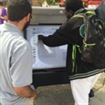November is near, and many people know what that means: people who are 18 and older in the U.S. are eligible to vote. On Nov. 6, many people will have the choice to vote in the midterm elections, but the question is often about how many people will choose to do it.
Daniel Lupo is fired up to vote in this year’s upcoming midterm election. The junior business major at Montclair State University is angry and looking to make a change.
Lupo is motivated enough to vote in the midterm elections.
“Trump wants to completely erase transgender people to make things more ‘normal,’” Lupo said. “Since I am part of the LGBTQ community, I am very angry and upset by his actions. I want to make it stop as soon as possible.”
Lupo wants to take a stand against President Donald Trump, which is motivating him to vote.
Lupo is not alone in his motivation to vote. Junior theater major James Hartmann is also ready for the election because of his stance on gun control.
“Gun control is something I’ve been wanting to change ever since the first time I voted in 2016,” Hartmann said. “Guns should only be used by officials, such as military and police officers. We can’t just keep giving anyone guns.”
According to the 2018 Voter Engagement Survey conducted by Public Religion Research Institute and the Atlantic, 28 percent of young adults are positive that they will participate in voting in the upcoming election. On the flip side, 74 percent of seniors are positive they will vote.
According to the Center for Information and Research on Civic Learning & Engagement (CIRCLE), the young adults’ voting rate has dropped by 4 percent in midterm elections. CIRCLE is a research group based at Tufts University that studies youth behavior and democracy.
Montclair State political science and law professor Brigid Harrison believes two of the most salient issues for young adults today are marijuana legalization and gun control. However, Harrison knows voter turnout for midterm elections is typically lower than for presidential election years.
In 2016, a presidential election year, the voter turnout among 18-to-29 year olds was 46.1 percent, according to United States Census data. In 2014, for the midterm election, voter turnout among 18-to-24-year-olds was 17.1 percent, according to CIRCLE.
Meanwhile, in 2008 when Barack Obama first ran for president, young people turned out in force. According to CIRCLE, 48.5 percent — the greatest percentage of young voters ever recorded — turned out to vote. Yet, in 2010 during the midterm election, voter turnout declined to 21.3 percent. When Obama ran for re-election in 2012, turnout among young people decreased slightly to 41.2 percent.
While data shows that there is lower turnout for midterm elections, Harrison believes that the 2018 midterm election may prove to be different.
“Many young people were stunned from the 2016 [presidential] election,” Harrison said. “That has been a mobilizing force.”
Harrison believes that young people are a “highly mobilized generation” and are influenced by emotional movements in media today.
“Anger does seem to be motivating young people in this election, as evidenced by both the #MeToo and Indivisible movements,” Harrison said.
Each election cycle, less young people decide not to vote. People are curious if age plays a role in this phenomenon.
Undeclared freshman Giovanna Conte turned 18 just a few months ago, but she does not plan on voting in November’s election.
“I feel as if it doesn’t matter to me because I am so young,” Conte said.
Many young people get stereotyped as selfish and unable to make big, informed decisions. This stereotype comes from movies, TV shows and most importantly, social media. This is very common for 18-to-24-year-olds, but it does not apply to all young adults.

Amir Botros, the university’s Andrew Goodman Foundation Ambassador, shows students how to use the voter ballot machine on 2017's Voter Registration Day.
Luis Negron | The Montclarion
Sophomore fashion studies major Natalie Rispoli is a young enthusiastic voter.
“I was so excited when I was finally able to vote,” Rispoli said. “The first election I ever voted in was the 2016 presidential election, and I have voted every year since.”
Rispoli is just one of the many young people who want to vote and want to make a difference. There are numerous young people out there who have voted every year since they have turned 18, but there are also many who fall into the age group of 18 to 24 who are not even registered to vote.
In 2008, there were 1.7 million people who fell in this age group who were not registered to vote. A lot of young adults claimed they did not know where or how to register, according to the Campus Vote Project.
Dr. Ariel Alvarez, a professor in the political science and law department at Montclair State, believes that young people are focused on their personal lives instead of voting.
“They just don’t care,” Alvarez said. “They are too busy with school, work and financial obligations that they can’t bring themselves to vote.”
We will see how the numbers play out on in this year’s midterm election on Nov. 6.


